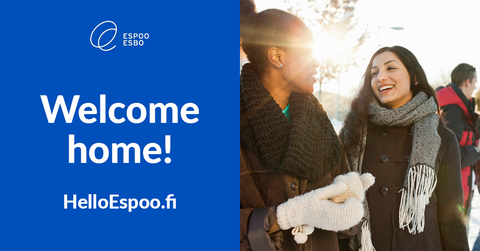“Welcome Home”: Finland’s six largest cities invite recent arrivals to use integration services
The six largest cities of Finland have come together to create a warm-hearted campaign to encourage new international residents to use the cities’ many helpful services for newcomers. At the start of 2025, overall responsibility for the provision of statutory integration services was transferred from the state to municipalities.
The Finnish cities of Helsinki, Espoo, Vantaa, Tampere, Turku and Oulu have teamed up to release a joint campaign designed to call attention to recent legislative changes that transfer select services to the country’s municipalities. The “Welcome Home” campaign encourages newly arrived residents to take full advantage of the respective cities’ many helpful services for newcomers. Among others, the cities’ statutory integration services can assist eligible jobseekers and people outside the labour force with adapting to Finnish society, learning the Finnish or Swedish language, and finding a job.
The Welcome home campaign will launch on the city’s digital channels on 10 February and continue for approximately two weeks. The message will be communicated in several languages, representing the language spoken most widely in each of the participating cities. It seeks to convey to current international residents or people who are planning to move or stay in Finland that the overall responsibility for the provision of statutory integration services now lies with Finland’s municipalities. The cities in question also hope to convey that they will be reliable and respectful partners in assisting their new residents to create and enjoy a good life in their new hometown.
Every tenth resident of Finland now speaks a foreign language
In 2023, the last year for which statistics are currently available, Finland’s population grew by almost 40,000 persons – the largest increase since 1956. This was in part explained by the arrival of people of people fleeing the war in Ukraine, who became eligible for residence in that year. According to Statistics Finland, every tenth resident of Finland now speaks a first language other than Finnish, Swedish or Sámi. Among the six cities participating in the campaign, the foreign-language population is 27 per cent in Vantaa, 24 in Espoo, 20 in Helsinki, 15 in Turku, 10 in Tampere and 6 in Oulu.
Another important goal of the Welcome home campaign is for the cities to send a message that all migrants are welcome, no matter what their background or the reason for arriving. Finland’s six largest cities recognise that newcomers to the country are important for many reasons.
In the city of Espoo’s strategy, known as the Espoo Story, the City Council has emphasised that “Everyone living in Espoo is an Espoo resident.” One of Espoo’s goals is to be “Finland’s top city for integration.”
About a fourth of Espoo residents speak something other than Finnish or Swedish as their native language. Foreign-language speakers account for about 80 per cent of the city’s population growth.
It is important that people from different backgrounds feel at home in Espoo and know that they can participate in developing the city.
Helping newcomers forge their own path
Integration is the process of people finding their own place in their new home country. The recently renewed KOTO24 Finnish Integration Act that in part inspired the campaign defines integration more narrowly, however, as it lays out the specific statutory services society must offer to migrants to the country. It also outlines which groups are entitled to these services.
People who have come to Finland and are actively seeking work or are outside of the labour force are encouraged to contact the city and begin using statutory integration services as soon as they arrive in the country. They should have received their first residence permit less than three years ago, but the integration services specialist conducting the initial assessment can make exceptions if a need for statutory integration services can be established. For example, parents or guardians that have been here longer caring for little ones at home are often still eligible to participate.
Each of the large cities participating in the “Welcome Home” campaign naturally provide a wide range of other services to help new arrivals of all kinds settle in and enjoy a good life in their municipality. People arriving from abroad who have already secured a job or study place also have a range of newcomer services to choose from have been designed to ease their transition.
City representatives are standing at the ready to direct people to the appropriate newcomer services, as well as to answer whatever questions new arrivals may have about employment, language classes, housing issues, children’s daycare and schools, and healthcare matters.
In Espoo, the Welcome home campaign links to the city’s Hello Espoo website which helps newcomers settle in. The HelloEspoo.fi site explains the basics of for example housing, childcare and finding a job as well as learning Finnish or Swedish. It also guides users on how to find multilingual information in the InfoFinland.fi online service or provides links to the services of the well-being services county, Kela and organisations.
The Hello Espoo website is particularly aimed at people who have been issued a residence permit less than three years ago. The website is available in three languages. We hope that AI will help increase the number of languages available.
When faced with a new life situation, many appreciate the option to discuss their concerns in person in addition to having information available online. The Hello Espoo Info is located in the service centre of the Iso Omena shopping centre, and it provides low-threshold advice on everyday life to foreign-language speakers living in Espoo. Help is available in plain Finnish and English. An interpreter is used if necessary.
